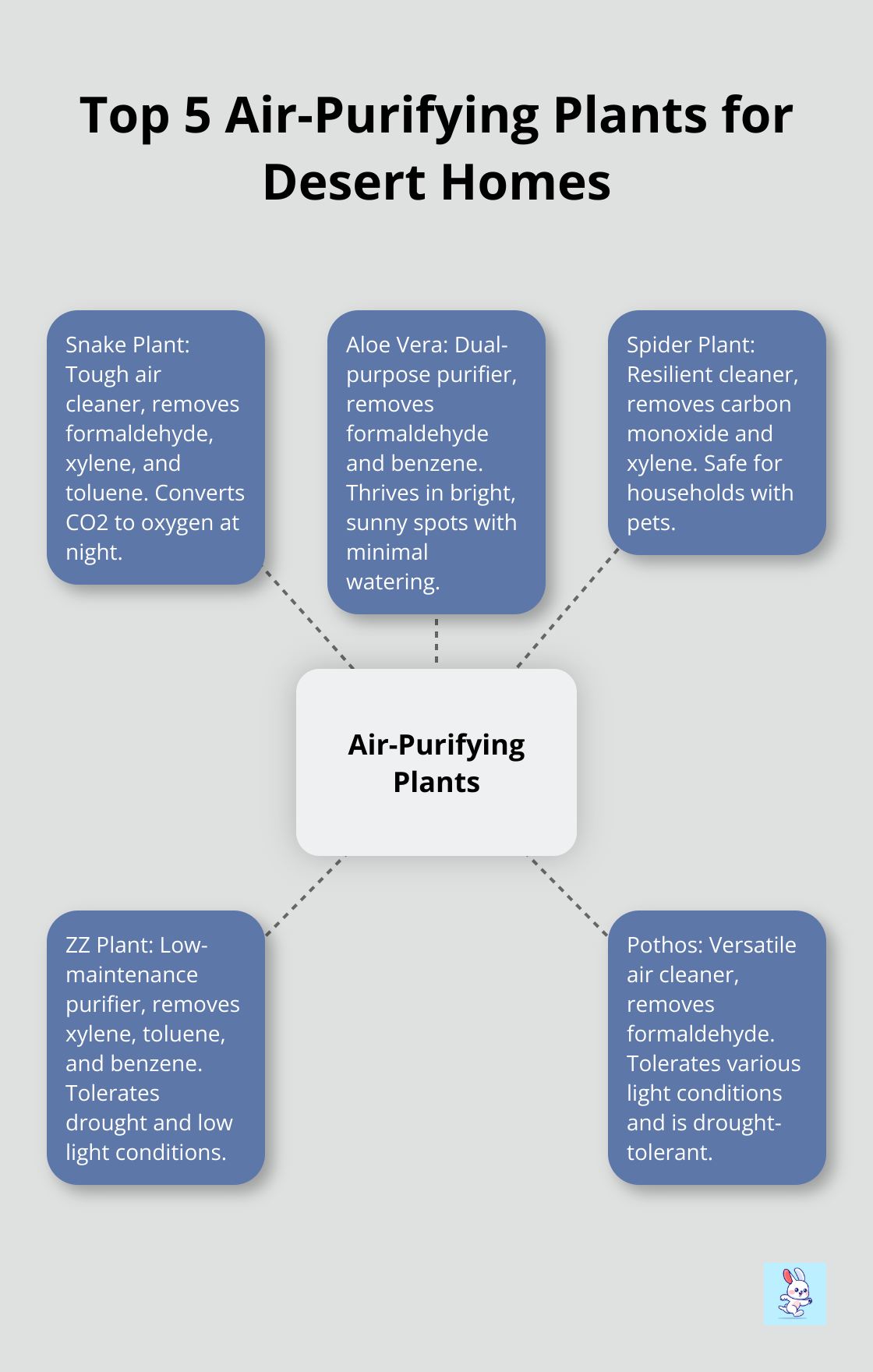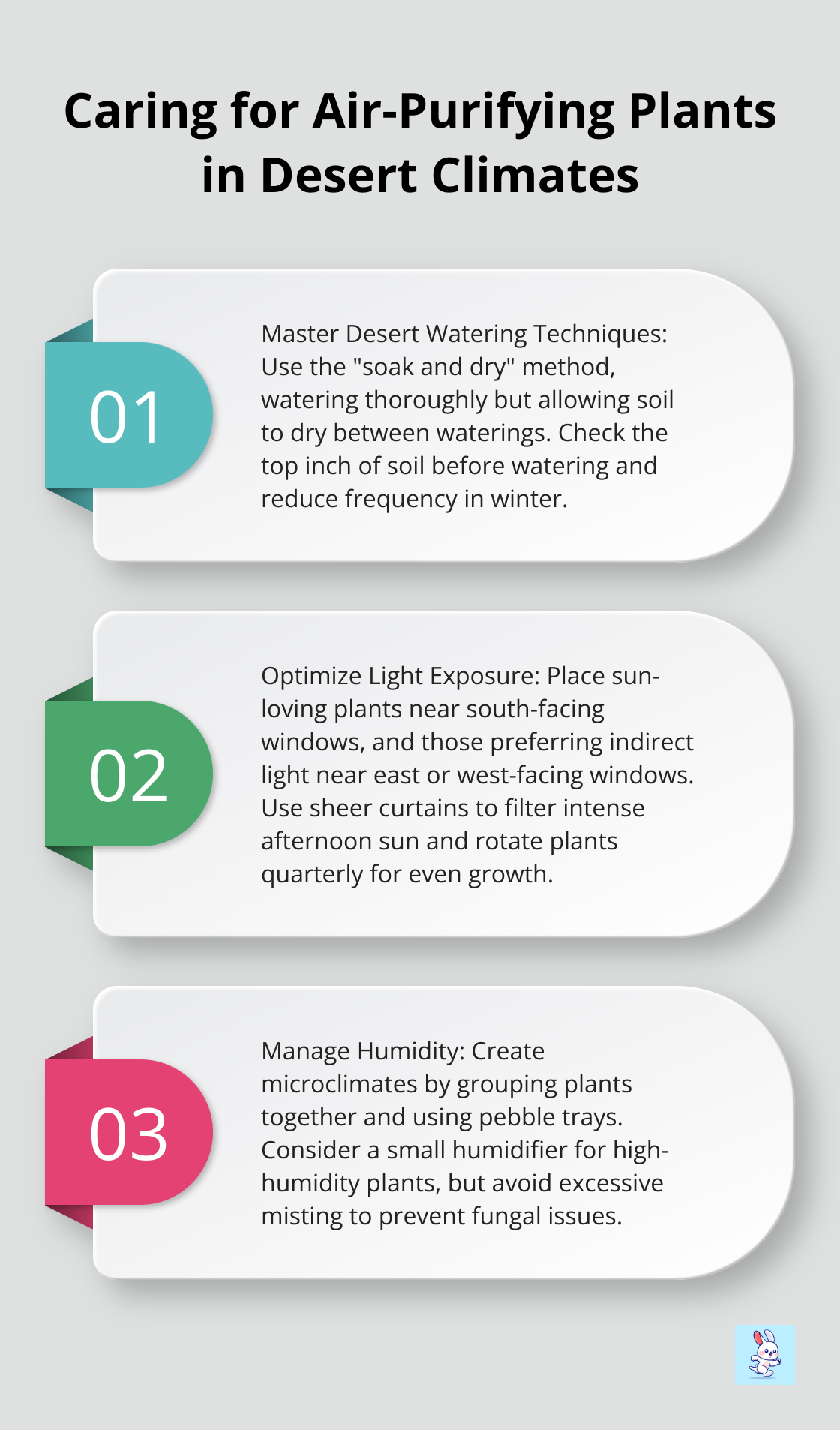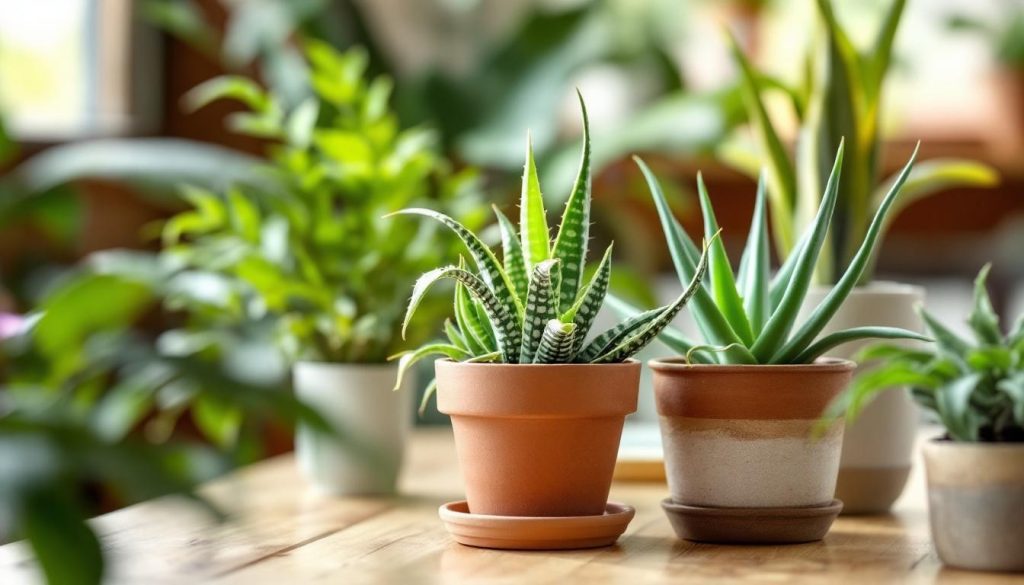Desert homes face unique challenges when it comes to air quality. Dust, allergens, and dry conditions can make indoor environments less than ideal for respiratory health.
At Cleaning Rabbit, we’ve found that air-purifying houseplants offer a natural solution to these issues. These green allies not only enhance your home’s aesthetics but also work tirelessly to clean the air you breathe.
In this guide, we’ll explore the best air-purifying plants for desert climates and share tips on how to care for them effectively.
Top 5 Air-Purifying Plants for Desert Homes
Desert homes face unique challenges in maintaining good air quality. Dust, allergens, and dry conditions can create less-than-ideal indoor environments for respiratory health. Certain houseplants thrive in these conditions while effectively purifying the air. Here are five top choices for desert dwellers who want to improve their indoor air quality:

Snake Plant: The Tough Air Cleaner
Snake Plants (Sansevieria) stand out as incredibly resilient and perfect for desert homes. They survive long periods without water and prefer bright, indirect light. NASA’s Clean Air Study highlights Snake Plants as excellent removers of formaldehyde, xylene, and toluene from the air. They also convert CO2 to oxygen at night (one of the few plants to do so), which makes them ideal for bedrooms.
Aloe Vera: Dual-Purpose Air Purifier
Aloe Vera does more than soothe sunburns; it purifies air powerfully. This succulent thrives in bright, sunny spots and needs minimal watering, perfect for desert climates. Aloe Vera removes formaldehyde and benzene from the air effectively. As a bonus, you can use its gel for various medicinal purposes.
Spider Plant: The Resilient Cleaner
Spider Plants prove hardy, fast-growing, and excellent air purifiers. They excel at removing carbon monoxide and xylene. These plants prefer bright, indirect light but tolerate lower light conditions. Their non-toxic nature makes them safe for households with pets.
ZZ Plant: The Low-Maintenance Purifier
ZZ Plants (Zamioculcas zamiifolia) show incredible drought tolerance and thrive on neglect, perfect for busy desert dwellers. They remove xylene, toluene, and benzene from the air excellently. ZZ Plants tolerate low light conditions but grow faster in brighter spots.
Pothos: The Versatile Air Cleaner
Pothos (also known as Devil’s Ivy) offers versatility and easy growth, great for air purification. It removes formaldehyde from the air particularly well. Pothos tolerates a wide range of light conditions, from low light to bright, indirect light. Its drought tolerance makes it an excellent choice for desert homes.
In desert climates, less often means more when it comes to plant care. Overwatering stands out as a common mistake, so always check the soil before watering. Most of these plants prefer to dry out between waterings.
While these plants work wonders for air quality, professional services can complement your efforts. CleaningRabbit stands out with over 20 years of experience serving Las Vegas and Henderson. Their use of advanced HEPA-filtered equipment ensures a healthier environment, working in tandem with your air-purifying plants for optimal indoor air quality.
How to Care for Air-Purifying Plants in Desert Homes
Desert homes present unique challenges for plant care. The arid climate demands specific techniques to help your green air cleaners thrive. Here’s how to maintain healthy air-purifying plants in desert conditions.

Master Desert Watering Techniques
In desert climates, water conservation is key. Overwatering kills more houseplants in arid regions than underwatering. Check the top inch of soil before watering. For succulents like Aloe Vera and Snake Plants, wait until the soil dries completely.
Use the “soak and dry” method: water thoroughly until it drains from the bottom, then allow the soil to dry out. This technique encourages deep root growth and drought resistance. Reduce watering frequency in winter as plants enter a semi-dormant state.
Optimize Light Exposure for Desert Plants
Desert homes often have intense sunlight, which can harm some air-purifying plants. Place sun-loving plants (like Aloe Vera) near south-facing windows. Position plants that prefer indirect light (such as Spider Plants and Pothos) near east or west-facing windows, or a few feet away from south-facing windows.
Filter intense afternoon sun with sheer curtains or blinds. Rotate your plants quarterly to ensure even growth and prevent leaning towards light sources.
Manage Humidity in Dry Desert Air
Desert air’s low humidity stresses many houseplants. Create a microclimate by grouping plants together. Place pebble trays filled with water beneath your plants; as the water evaporates, it increases local humidity without risking root rot.
Use a small humidifier for plants that need higher humidity (like some ferns). Avoid excessive misting, as it provides only temporary relief and can lead to fungal issues.
Select Appropriate Soil and Fertilizer
Well-draining soil is essential for desert plant care. Mix regular potting soil with perlite or coarse sand to improve drainage. Use a specialized cactus mix for succulents and cacti.
Fertilize sparingly in desert climates. Most air-purifying plants need fertilizer only during the growing season (spring and summer). Apply a balanced, water-soluble fertilizer at half the recommended strength every 4-6 weeks. Avoid over-fertilizing, as it can lead to salt buildup in the soil (a particular problem in dry climates).
These desert-specific care tips will help your air-purifying plants flourish, maximizing their ability to clean your indoor air. While plants excel at natural air purification, they work best alongside regular cleaning and maintenance. Professional services can complement your plant-based air purification efforts, ensuring comprehensive indoor air quality management.
Now that we’ve covered plant care, let’s explore the specific benefits these air-purifying plants bring to desert homes.
Why Air-Purifying Plants Are Essential in Desert Homes
Air-purifying plants serve as more than decorative elements in desert homes. They improve indoor air quality, which is particularly important in arid climates where dust and pollutants accumulate easily.

Natural Air Filtration System
Air-purifying plants remove common indoor pollutants. A NASA study suggested that certain common indoor plants may provide a natural way of removing toxic agents from the air. Desert dwellers benefit from cleaner air without relying solely on energy-consuming air purifiers.
Snake Plants effectively remove formaldehyde (often found in household cleaning products). A few Snake Plants in living areas significantly reduce the concentration of this harmful chemical.
Oxygen Boost in Dry Environments
Desert air often feels stale and dry. Air-purifying plants combat this by releasing oxygen and increasing humidity levels. The Spider Plant produces high amounts of oxygen. Adding Spider Plants to your bedroom improves air quality while you sleep.
Natural Humidifiers for Arid Climates
In desert regions with naturally low humidity, air-purifying plants increase moisture in the air. The Boston Fern (while not mentioned earlier due to higher care requirements in desert climates) acts as an excellent natural humidifier if provided with the right conditions.
For Las Vegas or Henderson residents, where humidity levels can be too low, you’ll feel the effects of colds, respiratory infections, and asthma more, and some of the furnishings in your home may be affected. These plants make a noticeable difference in indoor comfort. For comprehensive air quality management, professional services (like CleaningRabbit) use advanced HEPA-filtered equipment to complement the work of air-purifying plants.
Stress Reduction and Mental Health Benefits
Houseplants reduce stress and improve mental well-being beyond their air-cleaning capabilities. A study in the Journal of Physiological Anthropology revealed that interacting with indoor plants reduces both physiological and psychological stress.
In desert climates (where the outdoor environment sometimes feels harsh and uninviting), indoor greenery provides a much-needed connection to nature. The ZZ Plant, with its glossy leaves and low-maintenance nature, creates a calming indoor oasis in your desert home.
Improved Sleep Quality
Air-purifying plants contribute to better sleep quality. Plants like Aloe Vera and Snake Plants release oxygen at night, improving air quality in bedrooms. This enhanced air quality leads to more restful sleep and increased overall well-being.
Final Thoughts
Air-purifying houseplants offer a natural solution to improve indoor air quality in desert homes. The Snake Plant, Aloe Vera, Spider Plant, ZZ Plant, and Pothos excel at thriving in arid conditions while actively cleansing the air. These green allies remove common pollutants, increase oxygen levels, and boost humidity, which creates a healthier living environment.
Proper care techniques ensure these plants flourish in desert climates. Water sparingly, provide appropriate light exposure, manage humidity levels, and use well-draining soil with minimal fertilization. The benefits of air-purifying houseplants extend beyond air purification (they reduce stress, improve mental well-being, and enhance sleep quality).
Professional cleaning services complement the efforts of air-purifying plants for optimal results. CleaningRabbit enhances your indoor air quality with specialized air duct cleaning, HVAC sanitation, and air quality assessment services. Our advanced equipment ensures a comprehensive approach to create a healthier, more comfortable living environment in your desert home.

